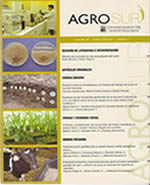Effect of blanching and temperature on the drying kinetic of the leaves of quinoa (Chenopodium quinoa Willd.), Salcedo INIA variety
Main Article Content
Abstract
The aim of this research was to compare the effects of pre-treatment (blanched in water and blanched in 3% NaCl solution) respect to control and drying temperatures (50, 60 and 70 °C) on quinoa leaves (Chenopodium Quinoa Willd.) variety Salcedo INIA. The study was carried out in a fixed bed dryer with continuous weight control. The parameters evaluated were the proximal chemical composition, the drying kinetics and the rehydration ratio of the leaves. The proximal contents of the samples blanched in 3% NaCl solution did not show significant differences P <0.05 with respect to the control in the content of fat, ash, fiber and protein. The drying rates of the control samples showed decreasing speeds curves, while the pre-treated, constant speeds. The experimental data were adjusted to the models of Henderson and Pabis, Midilli, Logarithmic, Page and Lewis; evaluating their validity with high values of R2, reduced by RMSE and χ2. The models of Midilli and Page were those that characterize the drying curves of quinoa leaves with coefficients of determination R2 high 0.9995-0.9985 with values of RMSE and χ2 low 0.0053-0.016 and 4.01x10-5 -1.23x10-4, respectively. The effective diffusivity of water varied from 3.871x10-12 to 1.175x10-11 m2 s-1 with activation energies of 32.66 to 56.044 kJ mol-1. The rehydration ratio of the samples blanched in water and dried at 50 °C presented the best index. The equilibrium moisture reached by the quinoa leaves, after the application of the pre-treatments varied between 388 to 135 minutes.

